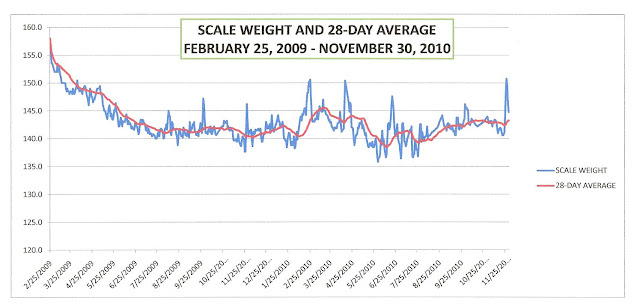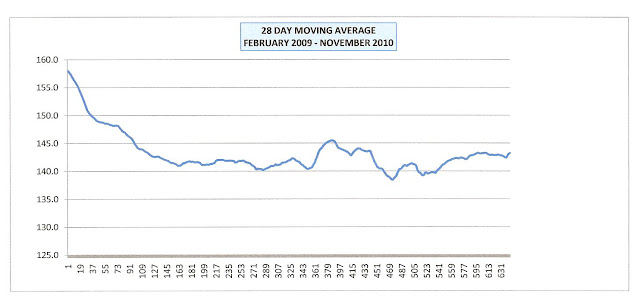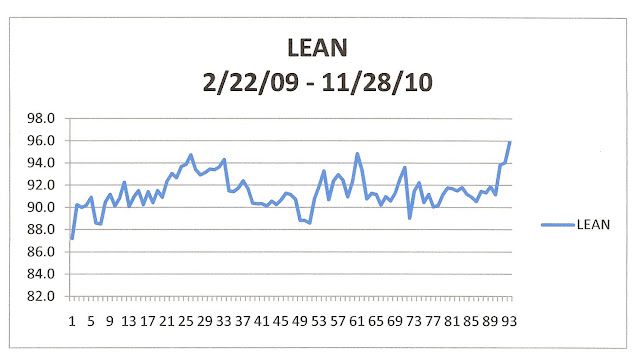
From Mark Sisson of
Mark' Daily Apple:
We all know that we need to exercise to be healthy.
Unfortunately,
the popular wisdom of the past 40 years – that we would all be better off doing 45 minutes to an hour a day of intense aerobic activity – has created a generation of overtrained, underfit, immune-compromised exerholics. Hate to say it, but we weren’t meant to aerobicize at the chronic and sustained high intensities that so many people choose to do these days. The results are almost always unimpressive. Ever wonder why years of “Spin” classes, endless treadmill sessions and interminable hours on the “elliptical” have done nothing much to shed those extra pounds and really tone the butt?
Don’t worry. There’s a reason why the current methods fail, and when you understand why, you’ll see that there’s an easier, more effective – and fun – way to burn fat, build or preserve lean muscle and maintain optimal health. The information is all there in the primal DNA blueprint, but in order to get the most from your exercise experience, first you need to understand the way we evolved and then build your exercise program around that blueprint.
Like most people, I used to think that rigorous aerobic activity was one of the main keys to staying healthy – and that the more mileage you could accumulate (at the highest intensity), the better. During my 20+ years as a competitive endurance athlete, I logged tens of thousands of training miles running and on the bike with the assumption that, in addition to becoming fit enough to race successfully at a national class level, I was also doing my cardiovascular system and the rest of my body a big healthy favor.
Being the type A that I am, I read Ken Cooper’s seminal 1968 book
Aerobics and celebrated the idea that you got to award yourself “points” for time spent at a high heart rate. The more points, the healthier your cardiovascular system would become. Based on that notion, I should have been one of the healthiest people on the planet.
Unfortunately, I wasn’t – and that same mindset has kept millions of other health-conscious, nirvana-seeking exercisers stuck in a similar rut for almost 40 years. It’s time to get your head out of the sand and take advantage of your true DNA destiny, folks!
The first signal I had that something was wrong was when I developed debilitating osteoarthritis in my ankles…at age 28. This was soon coupled with chronic hip tendonitis and nagging recurrent upper respiratory tract infections. In retrospect, it is clear now that my carbohydrate-fueled high-intensity aerobic lifestyle was promoting a dangerous level of continuous systemic inflammation, was severely suppressing other parts of my immune system and the increased oxidative damage was generally tearing apart my precious muscle and joint tissue.
The stress of high intensity training was also leaving me soaking in my own internal cortisol (stress hormone) bath. It wasn’t so clear to me at the time exactly what was happening – in fact it was quite confusing, since I was doing so much of this so-called “healthy” aerobic exercise – but I had no choice but to give up racing, unable to train at anywhere near the intensity required to stay at an elite level.
To make ends meet, I became a “personal trainer” and I refocused my attention on training average “non-athletic” people to achieve reasonable levels of general fitness and health. Of course, we lifted weights as part of the overall plan (and I will go into greater detail on that important aspect of fitness in a later post), but for the aerobic component of their training, I started doing long walks or hikes or easy bike rides with them. My many clients got the benefit of me actually working out right along side them and I got the benefit of 3 to 5 hours a day of very low intensity aerobic work (well, very low for me anyway). It was refreshing and really didn’t take much effort on my part, but I knew I had to be deriving at least some small benefit from those hours.
Since I didn’t have much time left in the week for my own workouts, once or twice a week I would do a very short but very intense workout for my own benefit, usually sprints at the track or “hill repeats” of 2-3 minutes each on the bike. Lo and behold, within a year, my injuries were healing, I was rarely sick and I was even back to occasionally racing – faster than ever. Something “primal” was happening and it made total sense in the context of the DNA blueprint. I was training like my hunter-gatherer ancestors, building my aerobic capacity slowly and steadily without overstressing my adrenals or my immune system, training my body to derive more energy from fats (and not glucose), requiring far fewer carbohydrate calories from my diet, and building muscle with occasional quick bursts of speed and intensity. I was suddenly both fit AND healthy. My
Primal Health system was kicking in and it all made perfect sense.
Humans, like all mammals, evolved two primary energy systems that powered the skeletal muscles of our hunter-gatherer ancestors 40,000 years ago and that would keep us all well-powered the same way today, if we weren’t so bent on circumventing them with our ill-fated (literally) lifestyle choices.
The first energy system relied heavily on the slow burning of fats, keeping us fueled while we were at rest or sleeping, yet also allowing for continuous or intermittent low levels of aerobic activity (think of our ancestors walking across the savannah for hours foraging for roots, shoots, berries, grubs, insects and the occasional small animal). It makes sense. Fats are very efficient fuels that are stored easily in the fat cells and burn easily and cleanly when lots of oxygen is present (as when we are breathing normally). Even if there’s no food in the immediate area, a well-trained fat-burning hunter-gatherer could continue walking and foraging for days without compromising his or her health or efficiency.
The second major energy system we developed through evolution was an ATP-fueled system that allowed for intense loads of work to be done in very brief bursts (think of our hunter-gatherer ancestors sprinting to the safety of a tree to avoid being eaten by a lion). ATP is always sitting right there within the muscle cells, available in a split second, and it is the highest octane fuel we have. In fact, it’s ATP and adrenaline that allow the little old lady to lift the front end of the Ford Fairlane off her husband when the jack fails. Unfortunately, the muscles can only store about 20 seconds worth of this precious fuel to complete life-or-death tasks. If our ancestors survived that quick sprint to safety, their ATP reserves were filled again within minutes using the other energy systems.
Furthermore, that brief burst of intense energy sparked a small “growth spurt” in the muscle, making it even stronger for the next encounter with the next lion – a true survival adaptation.
(Note: While our energy systems are actually quite complex, varied and interrelated, I have simplified things here to make it easier to “digest”.)
Bottom line: Fats and ATP were the two primary energy sources for locomotion: we either moved slowly and steadily or “fight or flight” fast, and we became stronger and healthier the more we used only those energy systems.
But here’s the real take-home message for us: We did not evolve to rely heavily on a carbodydrate-fueled energy system, and yet, carbohydrate metabolism seems to rule our lives today. Yes, carbohydrate (in the form of glucose) can play a major role in the production of energy in skeletal muscle, but it turns out that the heart and skeletal muscle prefer fatty acids (fat) as fuel over glucose.
Our hunter-gatherer ancestors didn’t regularly ramp their heart rates up for over an hour a day like so many of us do now. Even when the concept of organized hunting came along, it would appear that our hunter-gatherer ancestors relied more on superior tracking ability (using our highly evolved and exceptionally large brains) and walking (using our superior fat-burning systems), rather than on actually “chasing down” their prey. In fact, squandering valuable energy reserves (and increasing carbohydrate [glucose] metabolism by a factor of ten) by running hard for long periods of time was so counterproductive it would have likely hastened your demise (imagine chasing some game animal for a few hours and – oops – not succeeding in killing it. You’ve spent an incredible amount of energy, yet now you have no food to replace that energy. You have suddenly become some other animals prey because you are physically exhausted).
So, what does all that mean for us in the 21st century seeking to maximize our health and fitness?
Well, we know that this current popular high intensity aerobic pursuit is a dead-end. It requires huge amounts carbohydrate (sugar) to sustain, it promotes hyperinsulinemia (overproduction of insulin), increases oxidative damage (the production of free radicals) by a factor of 10 or 20 times normal, and generates high levels of the stress hormone cortisol in many people, leaving them susceptible to infection, injury, loss of bone density and depletion of lean muscle tissue – while encouraging their bodies to deposit fat. Far from that healthy pursuit we all assumed it was! What, then, is the answer?
Knowing what we know about our hunter-gatherer ancestors and the DNA blueprint, we would ideally devise an aerobics plan that would have us walking or hiking several hours a day to maximize our true fat-burning systems and then doing intermittent “life or death” sprints every few days to generate those growth spurts that create stronger, leaner muscle.
However, since allocating a few hours a day to this pursuit is impractical for most people, we can still create a plan that has a fair amount of low level aerobic movement, such as walking briskly, hiking, cycling at a moderate pace, etc a few times a week and keep it at under an hour. Then, we can add a few intense “interval” sessions, where we literally sprint (or cycle or do anything intensely) for 20, 30 or 40 seconds at a time all out, and do this once or twice a week.
If you are willing to try this new approach, but haven’t sprinted for a while, you may want to ease into it. Start with maybe three or four the first time, resting two minutes in between and, after a few weeks of doing this, work your way up to a workout that includes six or eight all-out sprints after a brief warm-up. An easy few minutes of stretching afterwards and you’ve done more in less time than you could ever accomplish in a typical “80-85% Max Heart Rate” cardio” workout. That’s exactly type of the plan I do myself and that I give all of my trainees now.
Let’s recap:
The benefits of low level aerobic work (walking, hiking, cycling, swimming):
- increases capillary network (blood vessels that supply the muscle cells with fuel and oxygen)
- increases muscle mitochondria
- increases production of fat-burning and fat-transporting enzymes
- more fun, because you can talk with a partner while doing it
The benefits of interval training (sprinting in short intense bursts)
- increases muscle fiber strength
- increases aerobic capacity (work ability)
- increases muscle mitochondria (the main energy production center in muscle)
- increases insulin sensitivity
- increases natural growth hormone production
The costs of chronic (repetitious) mid- and high-level aerobic work
- requires large amounts of dietary carbohydrates (SUGAR)
- decreases efficient fat metabolism
- increases stress hormone cortisol
- increases systemic inflammation
- increases oxidative damage (free radical production)
- boring!
To read the full article and comments,
click here.



















